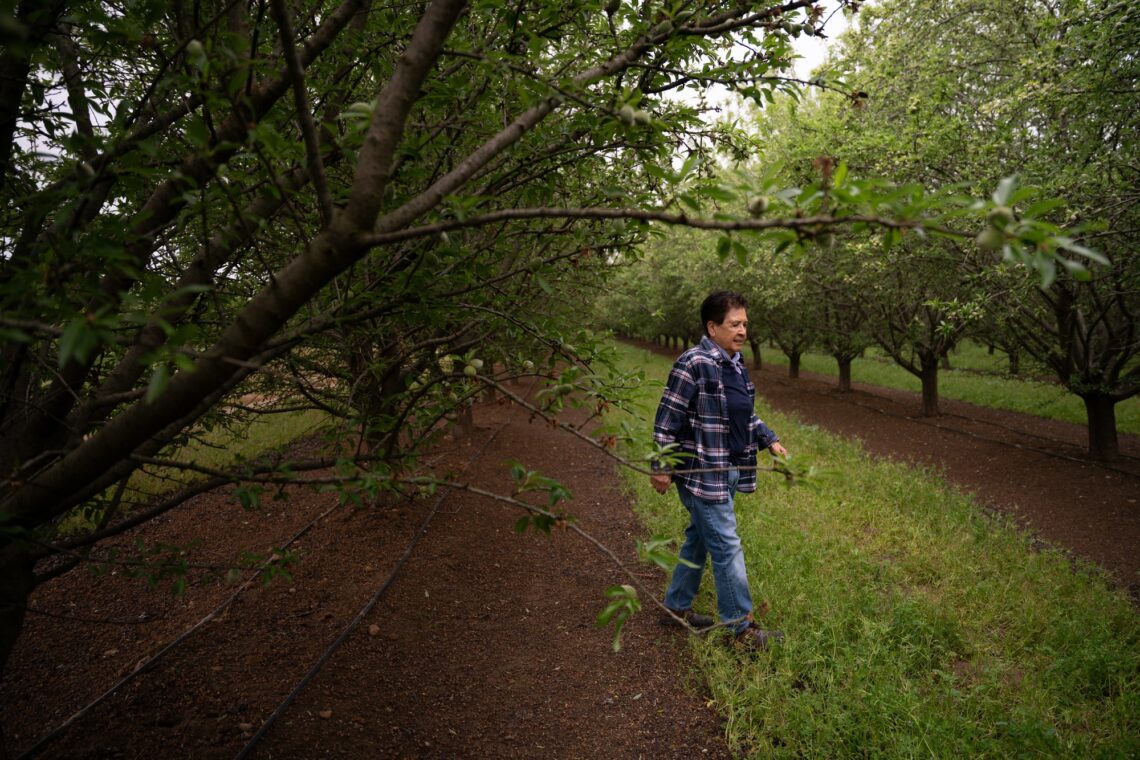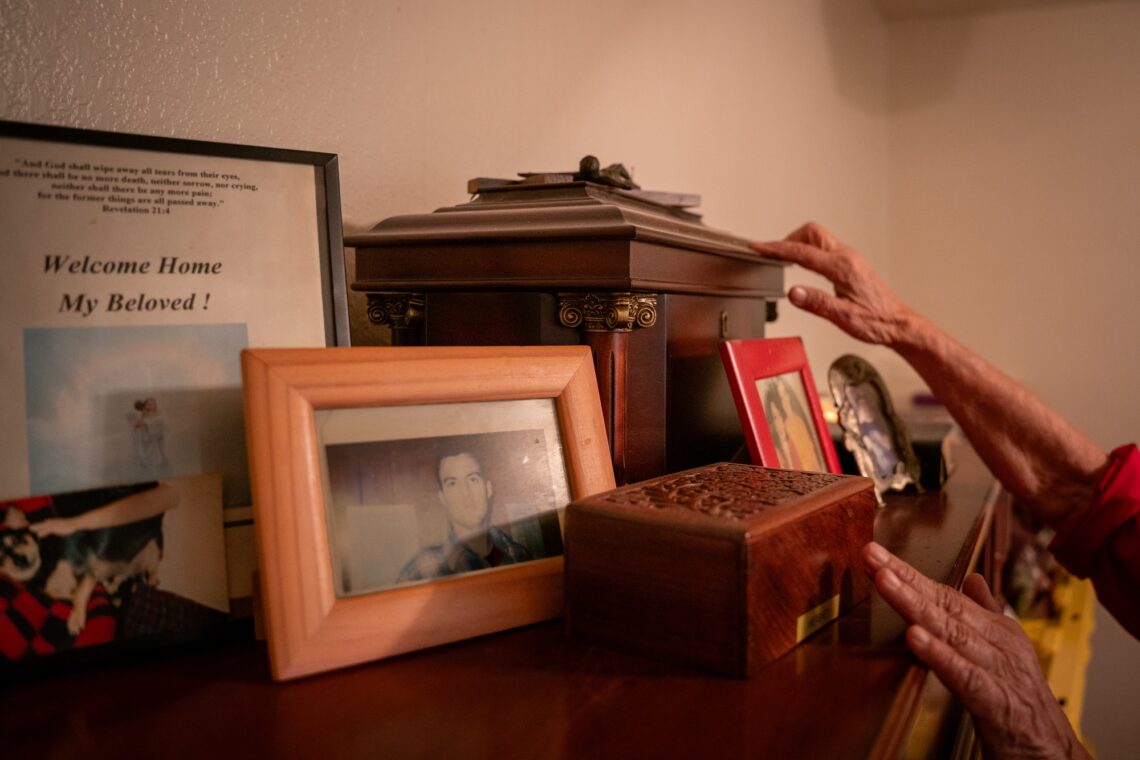The Enduring Reign of El Daña, Drag King of the Central Valley
By Celeste Hamilton Dennis. This story was originally published in KQED on June 21, 2024.

Elsie Saldaña, the oldest drag king still performing in the United States, on April 16, 2024, in Fresno, where she grew up and worked in the fields since she was 5 years old. (Florence Middleton)
For Elsie Saldaña, a flawless lip sync is the hallmark of serious artistry in drag.
She would know. Saldaña has been performing in the Central Valley since the 1960s and still occasionally graces the stage as El Daña — the oldest drag king in the country.

Elsie Saldaña strolls through a field in Fresno on April 16, 2024. For Saldaña, the orchards were not only a place of hard work but of refuge, where she would hang out with her queer friends. (Florence Middleton)
On a Saturday night earlier this year, she donned all black except for a rhinestone-studded belt as part of her transformation into the chest-baring crooner Tom Jones. She was about to perform his version of “Kiss” at the Red Lantern bar in Fresno and played the song on repeat in preparation, mouthing every word.
It had to be perfect — after all these years, she’s still one of the few drag kings in the lineup.
“For as old as I am to do this, I feel I have it in me,” she said. “And if I feel that I still have it in me, why should I stop?”

One of Elsie Saldaña’s drag performance outfits, adorned in rhinestones from top to bottom, rests on her bed in her home in Clovis on April 16, 2024. (Florence Middleton)
At 79 years old, she admits she can’t move like she used to. Yet she’s always ready for the next performance opportunity. Her rhinestone and sequin outfits are neatly stacked in her closet and Boot Barn boxes keep her Stetson cowboy hats pristine. She practices lip-synching in the car on her way to work as a house cleaner, driving past the few remaining orchards where she picked figs in her youth.

Elsie Saldaña, 79, at a client’s home that she regularly cleans for income in Fresno on April 16, 2024. (Florence Middleton)
Like many in the Fresno area, Saldaña grew up in a family of Mexican farmworkers. When she’d come home after long hours in the fields, she’d turn on the radio and lip-synch to Frank Sinatra or Vic Damone, pretending her hairbrush was a microphone.
The first time she performed for someone other than her reflection in the mirror was in 1965 at the Red Robin, a gay bar in town. The song was Ritchie Valens’ “La Bamba.” Her knees were shaking, but the claps and cheers from the audience made her feel like a star. She was hooked.

Elsie Saldaña mops the bathroom of a client’s home in Fresno on April 16, 2024. (Florence Middleton)
This launched a side career in drag where, for a long time, she was the only “male impersonator” in the area. (The term she preferred then.) In the beginning, Saldaña would stuff her male clothes in a paper bag to sneak past her mother, who she knew wouldn’t approve of drag, nor her being a lesbian.
She’d perform in big stage productions or solo shows at the few LGBTQ-friendly bars such as Girl of the Golden West, The Palace and Red Lantern — the only bar remaining.

Elsie Saldaña vacuums the living room of a client’s home in Fresno on April 16, 2024. The job requires moving furniture, including flipping over the recliner chairs to vacuum underneath them. (Florence Middleton)
Saldaña still gets nervous before a performance. On the night of her recent show, her coif was stiff with hairspray, her shirt sharply ironed, her bowtie snug. Tom Jones was her specialty. When she pushed the swinging door into the Red Lantern, where she performed “It’s Not Unusual” over four decades ago, it was like stepping into the past.
The black-and-white photos of shirtless cowboys on its walls are new, but the dance floor is the same, save for a glittering disco ball — a beacon of sorts.
“This area has a very rich and long history of drag and performance, mostly because of the bar network and Imperial Court,” said Kat Fobear, professor of Women, Gender and Sexuality Studies at Fresno State. “But it is in the face of historically and currently very conservative culture.”
The Imperial Court is one of the oldest LGBTQ organizations in the country and started in 1965 in the Bay Area — a time when homosexuality was considered a mental disorder and laws prohibited cross-dressing. The court was a way to foster pride and expanded to numerous cities, including Fresno, where it thrives to this day.
Members compete for royal titles and host fundraising drag balls. In 1980, Saldaña co-founded the Sequoia Empire Court in Visalia, back then a small town. She assumed the emperor’s title three times, raising thousands of dollars for AIDS and other charities. Her mother, eventually accepting who she was, would attend the balls.
“Visalia at that time really had a closeted community,” Saldaña said. “And once they found out about the court … they got brave.”

Elsie Saldaña looks at old family photos of her and her son Mark at her home in Clovis on April 16, 2024. (Florence Middleton)
During the ’80s and ’90s, Saldaña kept busy performing throughout California, working a day job in manufacturing, and being a mother to a son named Mark, who she raised with her partner at the time. Her son was her biggest fan — often giving her notes, always applauding.

Elsie Saldaña holds a headshot of herself from 1983 at her home in Clovis on April 16, 2024. (Florence Middleton)
Drag couldn’t pay the bills, however. She had to clock in more hours to survive, and, she said, she was a king in a world dominated by queens. RuPaul’s Drag Race television show eventually launched drag queens to mainstream popularity but notably absent were kings.
“A lot of people ask me, ‘How come drag kings aren’t known?’” said Mo Fischer, co-founder of Drag King History. “My answer is PMS: patriarchy, misogyny, sexism.”
As Saldaña aged, she started to feel like nobody wanted to see her on stage anyway. New kings came onto the scene — including nonbinary and trans performers — whose gender-bending, inventive approaches she didn’t always understand.

After cleaning a client’s home, Elsie Saldaña closes the trunk of her car with a license plate that reads, ‘El Daña,’ her drag king stage name, in Fresno on April 16, 2024. (Florence Middleton)
Then, her son Mark died suddenly when he was 29 years old. Saldaña left Fresno and took a break from drag for a decade. It was only when she returned in 2017 and met Fobear, who was working on an oral history project of LGBTQ elders that she began to see herself as Fobear saw her: a pioneer in drag long before drag was mainstream.

Elsie Saldaña, 79, on April 16, 2024, in her home in Clovis, California, wearing a white Stetson hat. She performed Glen Campbell’s ‘Rhinestone Cowboy’ at ‘Fresno Queer West’ last year, a drag show she organized to raise money for scholarships at Fresno State. (Florence Middleton)
And, Saldaña realized she still had dreams. Like seeing her name on the marquee at Fresno State’s massive arena. “My heart’s broken in a thousand pieces,” she said. “The only thing that saves me is when I entertain.”

Elsie Saldaña’s bedroom wall on April 16, 2024, in Clovis is adorned with awards, old photos, and memorabilia from her years of performing drag. This year, she was a recipient of a Harvey Milk Award from Fresno City Council for being a trailblazing entertainer. (Florence Middleton)
In the dressing room, before she stepped on stage at the Red Lantern, Saldaña said a prayer in hopes the performance would go well. She thought about her son Mark, whose encouragement always gave her strength.
A young drag king with a black cowboy hat who performed before her ran back into the dressing room when their song ended, hands still shaking. Saldaña assured them: “You did good. My first time, I was scared too.”

Elsie Saldaña in her home in Clovis on April 16, 2024, wearing one of her favorite drag outfits, a rhinestone cowboy suit. (Florence Middleton)
The emcee introduced “El Dañaaaaaa!” and she stepped on stage to a small but supportive audience, sparkling red curtains behind her. The music started low, and she gestured to turn it up. She was a bit thrown but swiveled her hips to the sultry beats. For those few minutes, everything that had been bothering her disappeared. She also remembered how good it felt to make others forget, too.

Elsie Saldaña touches her son’s urn at her home in Clovis on April 16, 2024. Saldaña keeps his ashes close and talks to him regularly. (Florence Middleton)
Roaring applause at the end confirmed for Saldaña what she’d always known: The stage is where she belongs. She basked in hugs and high fives and was already thinking about adding new choreography, improving her performance so it could be better. There’s always next time.

Elsie Saldaña at her home in Clovis on April 16, 2024. (Florence Middleton)
Celeste Hamilton Dennis originally reported and produced this story in the audio program at UC Berkeley’s Graduate School of Journalism. Shereen Marisol Meraji was her professor and lead editor.
The story also had support from UC Berkeley’s Investigative Reporting Program, where Florence Middleton is a photographer. The SCAN Foundation provided funding.

